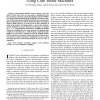1485 search results - page 28 / 297 » Group-Induced Vector Spaces |
TNN
2008
13 years 9 months ago
2008
Abstract--Large-margin methods, such as support vector machines (SVMs), have been very successful in classification problems. Recently, maximum margin discriminant analysis (MMDA) ...
ICASSP
2011
IEEE
13 years 1 months ago
2011
IEEE
Multistage residual vector quantizers (RVQ) with optimal direct sum decoder codebooks have been successfully designed and implemented for data compression. Due to its multistage s...
MIS
2011
Springer
13 years 4 months ago
2011
Springer
By exchanging events in a vehicular ad hoc network (VANET), drivers can receive information that allows them to find relevant places (e.g., parking spaces) or avoid dangerous/unde...
ICASSP
2011
IEEE
13 years 1 months ago
2011
IEEE
In supervector UBM/GMM paradigm, each acoustic file is represented by the mean parameters of a GMM model. This supervector space is used as a data representation space, which has...
ICASSP
2011
IEEE
13 years 1 months ago
2011
IEEE
Automatic music tagging is addressed by resorting to auditory temporal modulations and Parallel Factor Analysis 2 (PARAFAC2). The starting point is to represent each music recordi...

